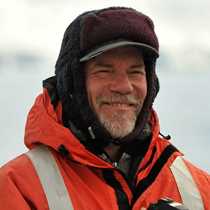Exploring Storfjorden
The surface of the sea is often a barrier. Reflecting light, it turns our sight away from the depths. We walk carefully around the small protuberances of its surface that we call inlets and bays. We’re even more careful about respecting this barrier if the water or the weather is cold. We don’t like to get wet and chilly, and cold seawater has a forbidding look, grey-green, dark, often choppy and restless.
In Svalbard, and throughout both polar regions, the surface of the sea is a more definite barrier, because it is often frozen solid. This solidified interface, which we call the pack ice, is a remarkable world of its own, uniquely beautiful, wild and foreign to us but home to ivory gulls and the ice bear. Although we seek out this world of frozen ocean for its strange scenery and wonderful wildlife, it reinforces the notion we carry of the barrier, the limit at the surface of the sea.
Breaking this barrier here in the Arctic requires quite a few pounds of gear: dry suit, double regulator, pony bottle, weights, hood, gloves, fins, cameras, it all adds up. But the effort is very much worth it. In fact, that restless mirrored surface is not really a barrier at all, it is a door into a rich and fascinating world. Here grow the forests of the Arctic, kelp that would tower over the diminutive plants on the shore. Here live fish and crabs and clams and seastars on craggy rocks, soft mud and rippled sandflats. Drifting in the dark waters we can find comb jellies like crystal Christmas tree ornaments and swimming snails beating delicate pink wings. Overhanging rocks are paved with sponges, ascidians and flower-like anemones, a brilliantly colored living mosaic. Everywhere you look, around the next corner, just a bit deeper, more wonders await.
So the next time you look down at the sea, try to see that the surface is a beginning, not an end. The door is open for anyone who wants to pass through; come on, I’ll show you around.
The surface of the sea is often a barrier. Reflecting light, it turns our sight away from the depths. We walk carefully around the small protuberances of its surface that we call inlets and bays. We’re even more careful about respecting this barrier if the water or the weather is cold. We don’t like to get wet and chilly, and cold seawater has a forbidding look, grey-green, dark, often choppy and restless.
In Svalbard, and throughout both polar regions, the surface of the sea is a more definite barrier, because it is often frozen solid. This solidified interface, which we call the pack ice, is a remarkable world of its own, uniquely beautiful, wild and foreign to us but home to ivory gulls and the ice bear. Although we seek out this world of frozen ocean for its strange scenery and wonderful wildlife, it reinforces the notion we carry of the barrier, the limit at the surface of the sea.
Breaking this barrier here in the Arctic requires quite a few pounds of gear: dry suit, double regulator, pony bottle, weights, hood, gloves, fins, cameras, it all adds up. But the effort is very much worth it. In fact, that restless mirrored surface is not really a barrier at all, it is a door into a rich and fascinating world. Here grow the forests of the Arctic, kelp that would tower over the diminutive plants on the shore. Here live fish and crabs and clams and seastars on craggy rocks, soft mud and rippled sandflats. Drifting in the dark waters we can find comb jellies like crystal Christmas tree ornaments and swimming snails beating delicate pink wings. Overhanging rocks are paved with sponges, ascidians and flower-like anemones, a brilliantly colored living mosaic. Everywhere you look, around the next corner, just a bit deeper, more wonders await.
So the next time you look down at the sea, try to see that the surface is a beginning, not an end. The door is open for anyone who wants to pass through; come on, I’ll show you around.




